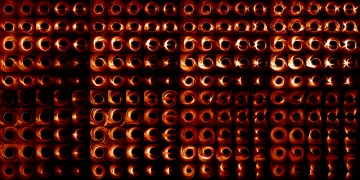
Images created by UArizona’s Chi-kwan Chan and University of Illinois’ Ben Prather as part of Event Horizon Telescope Collaboration.
The University of Arizona created the world’s largest library of black hole simulations to better identify and understand these phenomena.
The library offers millions of simulations built on variations in how plasma around a black hole interacts with its magnetic fields. Creating them required 80 million CPU hours of crunching equations for how matter and energy behave in extreme gravity – the equivalent to 2,000 laptops running at full tilt for a year, but condensed into two months.
Black holes are arguably one of the most compelling celestial objects for inspiring future scientists, and their study expands our understanding of everyday physics and our own cosmic backyard.
Led by Chi-Kwan Chan, associate astronomer at University of Arizona’s Steward Observatory, researchers used the library to learn more about Sagittarius A*, the black hole at the center of our Milky Way galaxy. Based on the closest match in the simulation library, Sagittarius A* is likely spinning and its accretion disk – the condensed gas, dust and plasma swirling around it – generates a magnetic field.
That information combined with 2019 findings about the black hole at the center of the Messier 87 galaxy – the first to be directly imaged – provides further support for Einstein’s paradigm shifting theory from 1905, that spacetime is flexible and warped by the intense mass and energy pulled into black holes.
